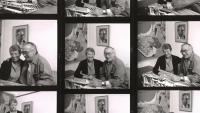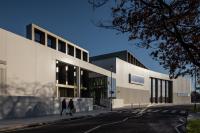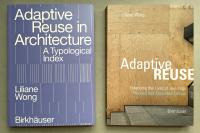Shuikou Area
Sanming, China
Shangping Village Regeneration - Shuikou Area
Selected as one of the “historical and cultural villages” in Fujian Province, Shangping Village has been sustained by its agricultural tradition and Hakka culture. In Shangping, most of the villagers have the surname of Yang, who are the descendants of Captain Yang Zhen from Han Dynasty. Shangping Village has a complete rural feng shui pattern where two streams run around the village and gather at Shuikou area (the water gap, village entrance). There are many provincial-level cultural heritages such as the Tai Fu Tai Mansion, the Yang’s Ancestral Temple, Shezumiao Shrine, Zhaogongmiao Temple, etc. According to the legend, the great scholar Zhu Xi used to give lectures in Shangping and to leave with treasured calligraphy. Therefore, Shangping has a reputation for "literary village surrounded by water ".
The regeneration of Shuikou area (the water gap, village entrance) is part of the important node construction in Shangping Village, as well as Yang’s School area and Tai Fu Tai Mansion area. Under the premise of protection, the design team has neither used the common way of “repairing old as old”, nor created the trendy mode of vernacular bed & breakfast. On the contrary, the design team has selected and transformed a number of abandoned agricultural facilities and infrastructures, such as cowsheds, pigsties, barns, and bamboo squeeze, etc.) with implanting upgraded industries, complementing tourism service facilities and providing a new economical platform. Based on the principles of locality and contemporariness, the design team has also designed cultural and creative products, provided business guidance and promotions which could be described as an integral service from conceptual planning to spatial construction, and to tourism products and promotion.
The site condition: vital location, but in urgent need of improvement
The Shuikou area is the village entrance, as well as for worship activities to ancestors and divinities. The existing buildings include the Shezumiao Shrine, the Yang’s Ancestral Temple, a gallery pavilion, a tobacco-curing house and a debris shed. To integrate with the buidlings, an ancient bridge, a magnolia tree, and lotus ponds constitute the landscape elements.
Apart from the Shezumiao Shrine and the Yang’s Ancestral Temple, the other buildings were not in ideal condition. The gallery pavilion was once hastily built for blocking off water in the 1980s (as a result of constructing the motorways that destroyed the feng shui pattern) that the main structure build by rubble stone was heavy and shoddy, whose closed form was not conducive to internal use and also blocked the sight of entrance into the village. The abandoned tobacco-curing house and debris shed were also negative elements.
Design tasks: supplementing service facilities, reshaping the Shuikou area
The Shuikou area is the gateway to the village with cultural heritages and landscape elements while in lack of service facilities for tourists. The location of the original gallery pavilion is very important that it is the landmark when entering the village and the conjunction connecting Yang's Ancestral Temple and the Shezumiao Shrine. However, the original pavilion failed to meet these demands and needed to transform. In addition, it is also vital to integrally re-use the abandoned buildings.
Transformation techniques: newness permeated in the old with artistic intervention
The design team neither deliberately pursued the retro form, nor used overly modern, urbanized form. Several new buildings at village node aims to present new style with the intention to keep locality at the same time so that the new buildings can preserves newness and antiquity.
The gallery pavilion: It needs to tear down the original pavilion with rubbery stone and to build a new one with more transparent corridor. It not only maintains traditional feng shui pattern of blocking sight and water, but also provides the good view for people who are sitting inside the corridor appreciating the surrounding scene and passers-by. Designers audaciously amend the external wall and create a semi- permeability effect by use of grilling on the basis of the raising-of-truss structure and open a landscape "window" in the semi-high position which is very modernistic at first glance but we can carefully see the regulations of Chinese traditional architecture of Tang and Song dynasties. The designers wish to establish an inheritance through the respect of the original faith and enable the locals to accept the new pavilion that the statues of worship for local people are well preserved and re-placed back to the original position of the new building. The lighting design further strengthens the symbolic spirit function of the village: at night, the returning villagers can see the lights at a very distant place that leads the way home.
Clouds Cafe: Clouds Cafe is a small house built on the original debris shed while keeping the form of local pergola, from which people can look down the pond in front. Shaped as a box with simple interior, the function of the building has been designed as a cafe for both locals and tourists to have a rest. For the facade facing to the village, the designers have adopt the wooden windows, one of whose sides are painted in color while another in plain, with axis to make a flexible while charming internal and external space. The designers hope that this new service facility will bring a dramatic "conflict" to the ancient village.
The tobacco-curing house: As a relic of traditional agriculture facility, the tobacco-curing house has important tourism value for urban residents to learn about traditional tobacco-making craftsmanship. The design team did not want to make the transformation as a simple reproduction of the original techniques but an artistic intervention was introduced: The tobacco-curing house has been molded into an ode to farming civilization and sun through a lighting installation. The sunlight would be intensified into colored lights from the skylight window. Designers hope it becomes a ritual place for people to reconsider the relationship between man and nature by artistic installation.
Project Information:
Project Name: Shangping Village Regeneration - Shuikou Area
Location: Xiyuan Town, Jianning County, Sanming City, Fujian Province, China
Client: People’s Government of Xiyuan Township
Architectural Design Company: 3andwich Design / He Wei Studio
Principal Architect: He Wei
Architectural Design Team: Zhao Zhuoran, Li Qiang, Chen Long, Chen Huangjie, Wang Lingzhe, Zhao Tong, Ye Yuxin, Song Ke
Building area: 159 sqm
Period of Design: Aug 2016 - Nov 2016
Period of Construction: Nov 2016 - Present
Lighting Design: Zhang Xin Studio, Tsinghua University School of Architecture
Lighting Design Team: Zhang Xin, Han Xiaowei, Zhou Xuanyu, Niu Bentian
Interior Construction Drawing: Hongshang Design
Photographer: Jin Weiqi, Ri Yue Lan Cao
- Architects
- 3andwich Design / He Wei Studio
- Location
- Xiyuan Town, Sanming, China
- Year
- 2016
- Client
- People’s Government of Xiyuan Township
- Team
- He Wei, Zhao Zhuoran, Li Qiang, Chen Long, Chen Huangjie, Wang Lingzhe, Zhao Tong, Ye Yuxin, Song Ke
- Lighting Design
- Zhang Xin Studio, Tsinghua University School of Architecture
- Interior Construction Drawing
- Hongshang Design























































